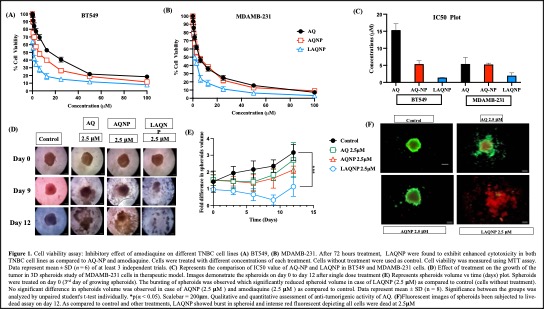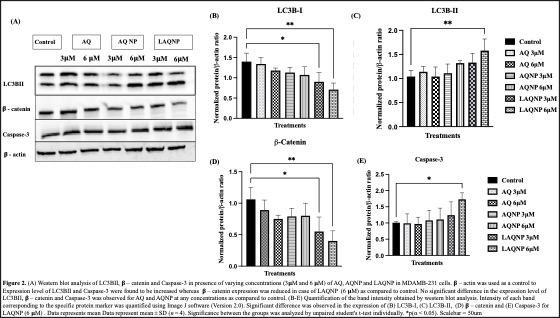Back
Purpose: Breast cancer is a heterogenous disease with high mortality rates worldwide. Breast cancer possess positive hormone receptor expression (estrogen, progesterone, and EGF). However, sometimes cells lack this expression and known as Triple Negative Breast Cancer (TNBC). Inability to target TNBC specifically possesses challenges to existing therapies. Therefore, there is a dire need to bolster the treatment options for TNBC. Amodiaquine (AQ) is known to act on several molecular targets involved in the growth and progression of cancer, therefore we investigated the potential of AQ against TNBC. Additionally, several reports suggest the presence of Luteinizing hormone releasing hormone (LHRH) receptors on the surface of TNBC cells which can be exploited towards TNBC. With these two aspects in mind, we discovered (via repurposing) AQ demonstrating efficacy against TNBC and further fabricated LHRH decorated AQ loaded nano drug delivery system to enhance AQ accumulation in tumoral mass and to curb the off-target side effects.
Methods: LHRH was conjugated with PLGA (Poly-lactic-co-glycolic acid) polymer (an acid terminated polymer) through EDC-NHS coupling reaction. The conjugation was confirmed via FTIR analysis. AQNP (AQ loaded nanoparticles) and LAQNP (AQ loaded nanoparticle containing LHRH) were prepared by double emulsification technique using PLGA and conjugated LHRH-Pol respectively. Fabricated nanoparticles were extensively characterized for their physicochemical and solid-state properties. In-vitro release profile of AQ from the fabricated delivery system was also evaluated via tube method at 370C to mimic the physiological conditions. AQNP and LAQNP were tested with phenotypic assays such as preliminary cytotoxicity on immortalized cell lines, colony formation assay, cellular internalization, and efficacy against 3D-cell-based models. Moreover, potential mechanistic pathways for AQ were discovered using western blotting, cell cycle analysis and in vitro autophagy and apoptosis.
Results: It was discovered that fabricated AQNP and LAQNP demonstrated efficacy in multiple phenotypic assays. However, LAQNP (due to LHRH presence) was able to portray significant reduction in the IC50 values compared to AQNP and AQ in TNBC cell lines - BT-549 - 1.4±0.9 𝛍M for LAQNP vs. 5.3±0.9 𝛍M for AQNP and 15.3±1.8 𝛍M for AQ; (Figs. 1A & 1C) and MDAMB-231 - 1.9±0.8 𝛍M for LAQNP vs. 5.2±0.4 𝛍M for AQNP and 5.4±1.8 𝛍M for AQ (Figs. 1B & 1C). Strong therapeutic efficacy was observed in 3D cell culture models (mimics physiological tumors more accurately than 2D models) (Figs. 1D & 1E). Further, better correlation of 3D tumor models and LAQNP efficacy was obtained through live-dead assay where strong red fluorescence (lacking in other treatment groups) observed in case of LAQNP showed more dead cells as compared to AQNP and AQ (Fig. 1F). AQ was discovered to act on multiple pathways such as inducing apoptosis and autophagy inhibition (highly relevant in TNBC progression) and simultaneously inducing p53 expression by downregulating 𝛃 – catenin levels (Fig. 2).
Conclusion: This one-of-a-kind study demonstrates the potential of an anti-malarial drug to tackle a complex disease like TNBC. Extensive phenotypic and mechanistic assays were performed to establish AQ’s efficacy as an anti-TNBC therapy. Moreover, a targeted drug delivery system was designed which showcased promising characteristics against TNBC. This delivery system can be exploited with approved chemotherapeutic agents. This delivery system can be utilized to extract maximum therapeutic benefits.

Figure 1. Cell viability assay: Inhibitory effect of amodiaquine on different TNBC cell lines (A) BT549, (B) MDAMB-231. After 72 hours treatment, LAQNP were found to exhibit enhanced cytotoxicity in both TNBC cell lines as compared to AQ-NP and amodiaquine. Cells were treated with different concentrations of each treatment. Cells without treatment were used as control. Cell viability was measured using MTT assay. Data represent mean ± SD (n = 6) of at least 3 independent trials. (C) Represents the comparison of IC50 value of AQ-NP and LAQNP in BT549 and MDAMB-231 cells. (D) Effect of treatment on the growth of the tumor in 3D spheroids study of MDAMB-231 cells in therapeutic model. Images demonstrate the spheroids on day 0 to day 12 after single dose treatment (E) Represents spheroids volume vs time (days) plot. Spheroids were treated on day 0 (3rd day of growing spheroids). The bursting of spheroids was observed which significantly reduced spheroid volume in case of LAQNP (2.5 𝛍M) as compared to control (cells without treatment). No significant difference in spheroids volume was observed in case of AQNP (2.5 𝛍M ) and amodiaquine (2.5 𝛍M ) as compared to control. Data represent mean ± SD (n = 8). Significance between the groups was analyzed by unpaired student's t-test individually. *p(α < 0.05). Scalebar = 200𝛍m. Qualitative and quantitative assessment of anti-tumorigenic activity of AQ. (F)Fluorescent images of spheroids been subjected to live-dead assay on day 12. As compared to control and other treatments, LAQNP showed burst in spheroid and intense red fluorescent depicting all cells were dead at 2.5𝛍M

Figure 2. (A) Western blot analysis of LC3BII, 𝛃 – catenin and Caspase-3 in presence of varying concentrations (3𝛍M and 6 𝛍M) of AQ, AQNP and LAQNP in MDAMB-231 cells. 𝛃 – actin was used as a control to Expression level of LC3BII and Caspase-3 were found to be increased whereas 𝛃 – catenin expression was reduced in case of LAQNP (6 𝛍M) as compared to control. No significant difference in the expression level of LC3BII, 𝛃 – catenin and Caspase-3 was observed for AQ and AQNP at any concentrations as compared to control. (B-E) Quantification of the band intensity obtained by western blot analysis. Intensity of each band corresponding to the specific protein marker was quantified using Image J software (Version 2.0). Significant difference was observed in the expression of (B) LC3B-I, (C) LC3B-II, (D) 𝛃 – catenin and (E) Caspase-3 for LAQNP (6 𝛍M) . Data represents mean Data represent mean ± SD (n = 4). Significance between the groups was analyzed by unpaired student's t-test individually. *p(α < 0.05). Scalebar = 50um
Formulation and Delivery - Chemical - Drug Delivery
Category: Poster Abstract
(T1530-03-14) LHRH-Targeted Nano-repurposed Drug Carriers for Triple Negative Breast Cancer Treatment
Tuesday, October 18, 2022
3:30 PM – 4:30 PM ET
- MG
Mimansa Goyal, Ph.D.
St. John's University
queens, New York, United States - MG
Mimansa Goyal, Ph.D.
St. John's University
queens, New York, United States
Presenting Author(s)
Main Author(s)
Purpose: Breast cancer is a heterogenous disease with high mortality rates worldwide. Breast cancer possess positive hormone receptor expression (estrogen, progesterone, and EGF). However, sometimes cells lack this expression and known as Triple Negative Breast Cancer (TNBC). Inability to target TNBC specifically possesses challenges to existing therapies. Therefore, there is a dire need to bolster the treatment options for TNBC. Amodiaquine (AQ) is known to act on several molecular targets involved in the growth and progression of cancer, therefore we investigated the potential of AQ against TNBC. Additionally, several reports suggest the presence of Luteinizing hormone releasing hormone (LHRH) receptors on the surface of TNBC cells which can be exploited towards TNBC. With these two aspects in mind, we discovered (via repurposing) AQ demonstrating efficacy against TNBC and further fabricated LHRH decorated AQ loaded nano drug delivery system to enhance AQ accumulation in tumoral mass and to curb the off-target side effects.
Methods: LHRH was conjugated with PLGA (Poly-lactic-co-glycolic acid) polymer (an acid terminated polymer) through EDC-NHS coupling reaction. The conjugation was confirmed via FTIR analysis. AQNP (AQ loaded nanoparticles) and LAQNP (AQ loaded nanoparticle containing LHRH) were prepared by double emulsification technique using PLGA and conjugated LHRH-Pol respectively. Fabricated nanoparticles were extensively characterized for their physicochemical and solid-state properties. In-vitro release profile of AQ from the fabricated delivery system was also evaluated via tube method at 370C to mimic the physiological conditions. AQNP and LAQNP were tested with phenotypic assays such as preliminary cytotoxicity on immortalized cell lines, colony formation assay, cellular internalization, and efficacy against 3D-cell-based models. Moreover, potential mechanistic pathways for AQ were discovered using western blotting, cell cycle analysis and in vitro autophagy and apoptosis.
Results: It was discovered that fabricated AQNP and LAQNP demonstrated efficacy in multiple phenotypic assays. However, LAQNP (due to LHRH presence) was able to portray significant reduction in the IC50 values compared to AQNP and AQ in TNBC cell lines - BT-549 - 1.4±0.9 𝛍M for LAQNP vs. 5.3±0.9 𝛍M for AQNP and 15.3±1.8 𝛍M for AQ; (Figs. 1A & 1C) and MDAMB-231 - 1.9±0.8 𝛍M for LAQNP vs. 5.2±0.4 𝛍M for AQNP and 5.4±1.8 𝛍M for AQ (Figs. 1B & 1C). Strong therapeutic efficacy was observed in 3D cell culture models (mimics physiological tumors more accurately than 2D models) (Figs. 1D & 1E). Further, better correlation of 3D tumor models and LAQNP efficacy was obtained through live-dead assay where strong red fluorescence (lacking in other treatment groups) observed in case of LAQNP showed more dead cells as compared to AQNP and AQ (Fig. 1F). AQ was discovered to act on multiple pathways such as inducing apoptosis and autophagy inhibition (highly relevant in TNBC progression) and simultaneously inducing p53 expression by downregulating 𝛃 – catenin levels (Fig. 2).
Conclusion: This one-of-a-kind study demonstrates the potential of an anti-malarial drug to tackle a complex disease like TNBC. Extensive phenotypic and mechanistic assays were performed to establish AQ’s efficacy as an anti-TNBC therapy. Moreover, a targeted drug delivery system was designed which showcased promising characteristics against TNBC. This delivery system can be exploited with approved chemotherapeutic agents. This delivery system can be utilized to extract maximum therapeutic benefits.

Figure 1. Cell viability assay: Inhibitory effect of amodiaquine on different TNBC cell lines (A) BT549, (B) MDAMB-231. After 72 hours treatment, LAQNP were found to exhibit enhanced cytotoxicity in both TNBC cell lines as compared to AQ-NP and amodiaquine. Cells were treated with different concentrations of each treatment. Cells without treatment were used as control. Cell viability was measured using MTT assay. Data represent mean ± SD (n = 6) of at least 3 independent trials. (C) Represents the comparison of IC50 value of AQ-NP and LAQNP in BT549 and MDAMB-231 cells. (D) Effect of treatment on the growth of the tumor in 3D spheroids study of MDAMB-231 cells in therapeutic model. Images demonstrate the spheroids on day 0 to day 12 after single dose treatment (E) Represents spheroids volume vs time (days) plot. Spheroids were treated on day 0 (3rd day of growing spheroids). The bursting of spheroids was observed which significantly reduced spheroid volume in case of LAQNP (2.5 𝛍M) as compared to control (cells without treatment). No significant difference in spheroids volume was observed in case of AQNP (2.5 𝛍M ) and amodiaquine (2.5 𝛍M ) as compared to control. Data represent mean ± SD (n = 8). Significance between the groups was analyzed by unpaired student's t-test individually. *p(α < 0.05). Scalebar = 200𝛍m. Qualitative and quantitative assessment of anti-tumorigenic activity of AQ. (F)Fluorescent images of spheroids been subjected to live-dead assay on day 12. As compared to control and other treatments, LAQNP showed burst in spheroid and intense red fluorescent depicting all cells were dead at 2.5𝛍M

Figure 2. (A) Western blot analysis of LC3BII, 𝛃 – catenin and Caspase-3 in presence of varying concentrations (3𝛍M and 6 𝛍M) of AQ, AQNP and LAQNP in MDAMB-231 cells. 𝛃 – actin was used as a control to Expression level of LC3BII and Caspase-3 were found to be increased whereas 𝛃 – catenin expression was reduced in case of LAQNP (6 𝛍M) as compared to control. No significant difference in the expression level of LC3BII, 𝛃 – catenin and Caspase-3 was observed for AQ and AQNP at any concentrations as compared to control. (B-E) Quantification of the band intensity obtained by western blot analysis. Intensity of each band corresponding to the specific protein marker was quantified using Image J software (Version 2.0). Significant difference was observed in the expression of (B) LC3B-I, (C) LC3B-II, (D) 𝛃 – catenin and (E) Caspase-3 for LAQNP (6 𝛍M) . Data represents mean Data represent mean ± SD (n = 4). Significance between the groups was analyzed by unpaired student's t-test individually. *p(α < 0.05). Scalebar = 50um
